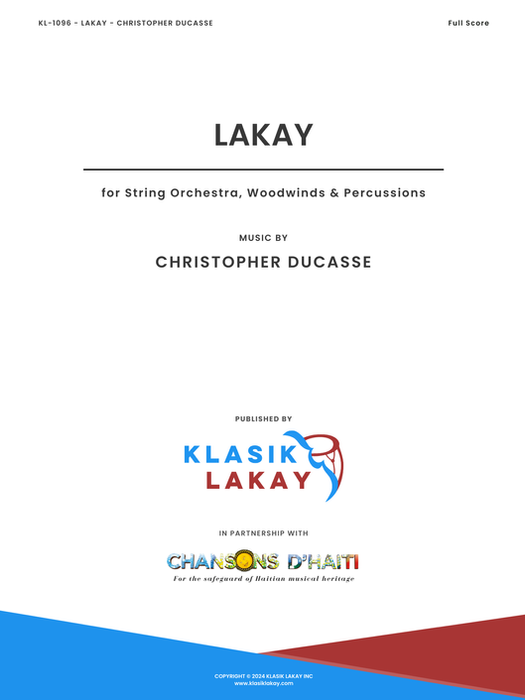
Fòs Nou (Full Orchestra)
Composer/Arranger
music by Christopher Ducasse
Instrumentation
for Full Orchestra
Piccolo - 2 Flutes - 2 Oboes - 2 Clarinets in Bb - 2 Bassoons
4 French Horns in F - 3 Trumpets in Bb - 2 Trombones - Trombone Bass - Tuba
Timpani - Cymbal - Tam Tam - Congas - Bongos - Glockenspiel
Harp - Violin I - Violin II - Viola - Cello - Bass
Duration
4:30 minutes
Fòs Nou (Full Orchestra)
$70.00
SKU:
KL-1065
Policy
Instrumental works include 1 Full Conductor Score and Parts (8/8/5/5/5 for strings, and 1 per any other instruments).
It is a breach of copyright law to make more copies than the amount purchased. Please order the number of copies needed for every member of the ensemble, including the conductor and the accompanist.
Sold by
Klasik Lakay
Digital (PDF)
Preview Score
Featured Video
Description
Commissioned by Kevin and April Ann Sütterlin as a gift to the Fox Valley Symphony Orchestra, in honor of Prof. Dominique-René De Lerma.
The title, "Fòs Nou" is a Haitian Creole title and translated to "Our Strength" in English. This composition is a mixture of western European classical music and Haitian Folk Rhythm. The core rhythm of Fòs nou is the "Yanvalou." Yanvalou, a Rhythm and Dance of Haiti gets its name after its associated movements. It is one of the most important rhythms in Haitian folklore; it is sometimes linked to "Knowledge," "Patience," "Healing," and "Strength."
With a combination of epic sound and Yanvalou, Fòs Nou expresses the strength and power we can demonstrate when working together. All the good we can bring to the world and all the greatness we can achieve. Inspired by the National Mantra of The Republic of Haiti, which says "L'union fait la force" (Unity is Strength).
Usually played on Three different congas named "Manman (mother)," "Segon (second)," and "Kata," the latter being always played with sticks on the body of a conga. I used one conga in to play a combination of the "manman" and "segon" rhythm and two bongos with sticks for a variation of the "Kata."
The beat of the rhythm of Yanvalou is a combination of Triple-Duple time (1-2-3 |1 2) in this composition, with three quarter-notes forming the triple and two dotted quarter-notes for the duple. Haitian Rhythms are mostly passed by oral tradition from mentors to apprentices drummers. Therefore, I had to create a notation sheet for the conga with the classical notation that would express the sound and soul of the rhythm. Furthermore, Haitian Rhythms use a lot of different sounds on a conga, which is impossible to notate clearly on the one or two stave line systems used by western music percussionists.
Description
Commissioned by Kevin and April Ann Sütterlin as a gift to the Fox Valley Symphony Orchestra, in honor of Prof. Dominique-René De Lerma.
The title, "Fòs Nou" is a Haitian Creole title and translated to "Our Strength" in English. This composition is a mixture of western European classical music and Haitian Folk Rhythm. The core rhythm of Fòs nou is the "Yanvalou." Yanvalou, a Rhythm and Dance of Haiti gets its name after its associated movements. It is one of the most important rhythms in Haitian folklore; it is sometimes linked to "Knowledge," "Patience," "Healing," and "Strength."
With a combination of epic sound and Yanvalou, Fòs Nou expresses the strength and power we can demonstrate when working together. All the good we can bring to the world and all the greatness we can achieve. Inspired by the National Mantra of The Republic of Haiti, which says "L'union fait la force" (Unity is Strength).
Usually played on Three different congas named "Manman (mother)," "Segon (second)," and "Kata," the latter being always played with sticks on the body of a conga. I used one conga in to play a combination of the "manman" and "segon" rhythm and two bongos with sticks for a variation of the "Kata."
The beat of the rhythm of Yanvalou is a combination of Triple-Duple time (1-2-3 |1 2) in this composition, with three quarter-notes forming the triple and two dotted quarter-notes for the duple. Haitian Rhythms are mostly passed by oral tradition from mentors to apprentices drummers. Therefore, I had to create a notation sheet for the conga with the classical notation that would express the sound and soul of the rhythm. Furthermore, Haitian Rhythms use a lot of different sounds on a conga, which is impossible to notate clearly on the one or two stave line systems used by western music percussionists.





































